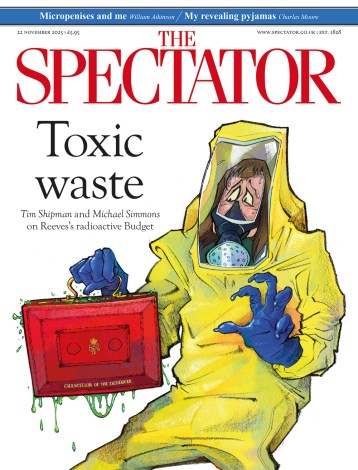End-of-life plans
Sir: Charles Moore writes about his neighbour with poor lung function being telephoned about a ‘Do Not Resuscitate’ order (Notes, 18 April). Even today when I discuss end-of-life plans with patients in A&E, many immediately think that medical staff are giving up on them. Nothing could be further from the truth. What are actually called DNA-CPR decisions do not stop treatment for a health condition. What it does is say that if this patient were to die, then chest compressions (which often break ribs) and intubation will in all likelihood not work, and that allowing the natural end of life to occur peacefully is better.
Part of the reforming of the health and social care landscape after the Covid-19 situation has passed will be explaining to the public just what these documents are for. In hospitals now, a DNA-CPR decision is accompanied by another form which outlines after discussion with the patient and/or family what the limit of treatments should be. Such treatment escalation plans are of benefit, as they show all the treatments that the clinical team feel will have maximum benefit.
Dr David Shackleton
London W13
Keep your admiration
Sir: Douglas Murray (‘I love my strange, disagreeable tribe’, 25 April) says he has no idea whether I am right or wrong about whether the government has acted correctly over the coronavirus. Why on earth not? I have not endured having a hundred buckets of slime tipped over my head over the past few weeks to provide a sort of sporting spectacle for Douglas or anyone else to enjoy. I do not argue for the sake of it. I loathe the abuse and the solitude as much as anyone might expect me to. I see my country in danger of grave and lasting threats to its freedom and its prosperity. I fear a future of over-mighty officials and police displaying the unbridled insolence of office, a dead political consensus, combined with confiscatory tax, shrivelled savings and pensions, lower wages and standards of living, and diminished hopes for the young. I thought it my duty to use my wits, such as they are, my sense of proportion and my many years of education and experience (for which I owe a debt to my parents, my country and my trade that I cannot repay) to oppose this danger. Nobody of any sense can fail to take sides or care about this. If Douglas wants to support this idiocy, he should say so. If he is against it, then he should say so. But he can keep his useless admiration for my ‘argumentative’ and ‘unintimidateable’ nature.
Peter Hitchens
London W8
Churchill’s face mask
Sir: ‘Would Churchill have worn a face mark?’ asks Rod Liddle (25 April). Probably yes, but with some alterations. During the war, Churchill had to don an oxygen mask during a high-altitude airplane flight, where he was to be confined in an unpressurised cabin. A special mask was made for him that allowed him to smoke his beloved cigars. A similar mask might help Mr Liddle in the near future.
Patrick van IJzendoorn
London SE3
Rural lockdown
Sir: Melanie McDonagh’s tirade against the advantages of rural living is overwrought (‘Lie of the land’, 18 April). Country and town are in this mess together; it just impacts in different ways. Sure, some of us have fields of gambolling lambs to walk through. But there is no public transport and a visit to the supermarket, chemist or doctor requires a 15-mile round trip, mostly on lanes that are in a sorry state. The mobile phone signal is flaky and the internet connection gives the impression that the electrons are individually delivered by carrier pigeon. This scuppered my plans to learn via the internet to play the guitar and speak Welsh — not to mention hindering people trying to ‘work from home’. It also precludes Netflix, podcasts and renders Zoom calls with my family (or anyone else) voice only. In a hamlet of just six dwellings social distancing is indeed easy; avoiding complete isolation is not.
I chose to live here and am not complaining — as a misanthropic middle-aged man I am content in my own company. However, when the highlight of my week is seeing frightened, silent, masked strangers two metres away in a supermarket queue, I sometimes think that I may be close to having too much of a good thing.
Patrick Benham-Crosswell
Hucking, Kent
RIP Roy Kerridge
Sir: I was sorry to hear of the death of Roy Kerridge (Notes, 18 April). When I first read a copy of The Spectator (in 1980 — I’d swapped it for a Private Eye with a total stranger during a train journey), it was Roy’s quirky article that made me realise that this was more than just a political mag. His piece described some sort of alternative religious gathering where one group of people shouted ‘Shollygoblin!’ to which another group retorted ‘Crowbush Salamander!’. I’ve never forgotten shaking with laughter as I got out of the carriage, and I became a subscriber shortly afterwards. RIP Roy.
J.C.H. Mounsey
Minchinhampton, Glos
Universal Basic Income
Sir: The leading article (‘The case for trust’, 25 April) tells that The Spectator was fighting for the extension of the franchise prior to the 1832 Reform Act. Is it open to a modern battle at an opportune time to empower many more? Universal Basic Income is surely an idea whose time has come. Under Covid-19, the government on the one hand is pouring patchy financial support into some businesses through a hotch-potch of measures, while Universal Credit has been showing that it is an inadequate personal welfare idea even in high employment times. In certain ways, UBI would address both these issues rather better by giving a financial backstop to every individual in the new unknown, post-Covid ‘normal’.
James Forsyth (‘The communitarian Conservatives’, 18 April) quotes Rishi Sunak: the ‘simple idea that we depend on each other’. The Citizen’s Income Trust has done much research and has careful proposals to make UBI affordable and workable. In the times of high unemployment likely to be ahead, Conservatives could catch trending communitarianism by helping individuals and families directly. The time is ripe for a new empowering of citizens.
Charles Bazlinton
Alresford, Hants
Put out to furlough
Sir: We enjoyed Dot Wordsworth on the term ‘furlough’ (Mind your language, 25 April). My wife works for a large publishing house and has been furloughed. She thinks of it in terms agricultural, ‘I have been laid furlough’, or equestrian: ‘I have been put out to furlough.’
Tom Page
London N8
Unfair to the Archbishop
Sir: David Akerman is unfair to the Archbishop of Canterbury (Letters, 25 April). The closing of church buildings was not taken lightly, but was an attempt to minimise the spread of the coronavirus. And to decry his decision to broadcast from his kitchen and applaud the Pope for broadcasting in a nearly empty St Peter’s is quite unnecessary. How can an Easter Day Holy Communion celebrated in a kitchen be so inappropriate, when its institution took place in a dining room? The addresses of both men were excellent, affirming the resurrection of Christ as a powerful event which counteracts the misery of being caught up in the crisis. The Archbishop’s challenge to the nation to use this situation to create a better society was both well expressed and timely. His leadership, so far from causing damage, is an inspiration to me and to many other Anglican clergy and laity.
Revd Richard Rice-Oxley (retired)
Swinstead, Lincolnshire
Remember Jennifer Paterson
Sir: I loved this issue as always, but while mentioning many of your past distinguished contributors you omitted to mention Jennifer Paterson, later of Two Fat Ladies fame, who not only cooked lunches for you but was also commissioned to write weekly recipes — which did often include a few mistakes, such as wrong quantities. In what must have been a very rare sense-of-humour failure, the then editor Charles Moore sacked her for throwing all the cutlery out of the window in a fit of pique. But you must admit she was a most unforgettable figure.
Virginia Cecil
London SW10
Authority tissues
Sir: The Izal debate I see continues (Letters, passim). How many of your readers would remember the interleaved tissues provided in King’s College London (I went up in 1962) that were branded at one end ‘KING’S COLLEGE LONDON’ and at the other end with the exhortation ‘NOW WASH YOUR HANDS’.
Richard Howe
Yaoundé, Cameroon
How the other halfs live
Sir: Thank you for the hilarious feature on Spectator writers in lockdown as seen by their partners (25 April). Caroline Bondy and the Builder Boyfriend’s pieces were hysterical, and well worth the subscription price. The other insights were terrific as well, not least into the Cummings-Wakefield household, and the Pinochet references to Rod Liddle. Can we have Carrie Symonds at Chequers, please?
John Van der Gucht
Cross Hills, North Yorkshire
Beware beards
Sir: I have tried to lead my life under three lodestars, handed to me on a scrap of paper at the altar by my best man. The first two are none of your business and anyway now irrelevant. The third is: ‘Beware earnest bearded men’ (Notes on beards, 25 April). I am knocking on 80 and, with this advice to sustain me, cracking along at a pace.
John Hardy Clarke
Caythorpe, Lincs
Vera Lynn got there first
Sir: Anthony Jennings (Letters, 18 April) correctly points out Alan Johnson’s error in overlooking Lonnie Donegan’s US chart hits (‘Saviours of the world’, Books 28 March), but both overlooked another artist and an important point in US popular music history. The first British artist to top the US Billboard charts recently celebrated her 103rd birthday. Vera Lynn topped the US Billboard charts in 1952 with ‘Auf Wiedersehn, Sweetheart’, the first song recorded by a foreign artist to do so.
David Wood
Glen Waverley, Victoria, Australia
80 years of reading
Sir: Your 10,000th issue reminded me of the first Spectator I read nearly 80 years ago…and I haven’t missed a single one since.
Coral Samuel
London W8
Write to us: Please email letters@spectator.co.uk since posted letters may not be read at the moment.






Comments